Characterizing Precipitation Variability and Trends in the World’s Mediterranean-Climate Areas
Abstract
:1. Introduction
2. Methods
2.1. Climate of the Mediterranean Biome
- Mean annual precipitation greater than 300 mm (suggesting at least semiarid conditions) [14].
- More than 50% of the mean annual precipitation occurring during the cool half of the year, from mid-fall through winter to mid-spring (which we abbreviate FWS). For dry-summer climate areas, we defined the FWS period as the wetter of either October–March or November–April in the northern hemisphere; and either April–September or May–October in the southern hemisphere.
- Less than 20% of the mean annual precipitation occurring during the summer three months. For each of the five Mediterranean-climate areas, we defined the summer period as the drier of either June–August or July–September in the northern hemisphere; and either December–February or January–March in the southern hemisphere.
- Mean coldest-month temperature is greater than 0° Celsius (indicating a likelihood of precipitation predominantly occurring as rainfall rather than snowfall).
2.2. Interannual Precipitation Variability and Trends
2.2.1. Interannual Variability
2.2.2. Interannual Trends in Annual Precipitation, Winter Precipitation, and Summer Precipitation; and Variability
3. Results
3.1. Climate of the Mediterranean Biome
3.2. Interannual Variability
3.3. Trends
3.3.1. Annual Trends
3.3.2. FWS Trends
3.3.3. Summer Trends
4. Discussion
4.1. The Mediterranean Climate as a Function of Annual Precipitation and Seasonality
4.2. Interannual Variability
4.3. Trends
5. Conclusions
Supplementary Materials
Acknowledgments
Author Contributions
Conflicts of Interest
References
- Carpenter, S.R.; Mooney, H.A.; Agard, J.; Capistrano, D.; DeFries, R.S.; Díaz, S.; Dietz, T.; Duraiappah, A.K.; Oteng-Yeboah, A.; Pereira, H.M.; et al. Science for managing ecosystem services: Beyond the Millennium Ecosystem Assessment. Proc. Natl. Acad. Sci. USA 2009, 106, 1305–1312. [Google Scholar] [CrossRef] [PubMed]
- Parmesan, C. Ecological and evolutionary responses to recent climate change. Annu. Rev. Ecol. Evol. Syst. 2006, 37, 637–669. [Google Scholar] [CrossRef]
- Westerling, A.L.; Hidalgo, H.G.; Cayan, D.R.; Swetnam, T.W. Warming and earlier spring increase western US forest wildfire activity. Science 2006, 313, 940–943. [Google Scholar] [CrossRef] [PubMed]
- Breshears, D.D.; Cobb, N.S.; Rich, P.M.; Price, K.P.; Allen, C.D.; Balice, R.G.; Romme, W.H.; Kastens, J.H.; Floyd, M.L.; Belnap, J.; et al. Regional vegetation die-off in response to global-change-type drought. Proc. Natl. Acad. Sci. USA 2005, 102, 15144–15148. [Google Scholar] [CrossRef] [PubMed]
- Prentice, I.C.; Cramer, W.; Harrison, S.P.; Leemans, R.; Monserud, R.A.; Solomon, A.M. Special paper: A global biome model based on plant physiology and dominance, soil properties and climate. J. Biogeogr. 1992, 19, 117–134. [Google Scholar] [CrossRef]
- Millennium Ecosystem Assessment. Ecosystems and Human Well-Being: Synthesis; Island Press: Washington, DC, USA, 2005. [Google Scholar]
- Piao, S.; Ciais, P.; Huang, Y.; Shen, Z.; Peng, S.; Li, J.; Zhou, L.; Liu, H.; Ma, Y.; Ding, Y.; et al. The impacts of climate change on water resources and agriculture in China. Nature 2010, 467, 43–51. [Google Scholar] [CrossRef] [PubMed]
- Patz, J.A.; Campbell-Lendrum, D.; Holloway, T.; Foley, J.A. Impact of regional climate change on human health. Nature 2005, 438, 310–317. [Google Scholar] [CrossRef] [PubMed]
- Ruhí, A.; Holmes, E.E.; Rinne, J.N.; Sabo, J.L. Anomalous droughts, not invasion, decrease persistence of native fishes in a desert river. Glob. Chang. Biol. 2015, 21, 1482–1496. [Google Scholar] [CrossRef] [PubMed]
- Deitch, M.J.; Dolman, B. Restoring Summer Base Flow under a Decentralized Water Management Regime: Constraints, Opportunities, and Outcomes in Mediterranean-Climate California. Water 2017, 9, 29. [Google Scholar] [CrossRef]
- Kottek, M.; Grieser, J.; Beck, C.; Rudolf, B.; Rubel, F. World map of the Köppen-Geiger climate classification updated. Meteorol. Z. 2006, 15, 259–263. [Google Scholar]
- Peel, M.C.; Finlayson, B.L.; McMahon, T.A. Updated world map of the Köppen-Geiger climate classification. Hydrol. Earth Syst. Sci. Discuss. 2007, 4, 439–473. [Google Scholar] [CrossRef]
- Conacher, A.J.; Conacher, J. Introduction. In Land Degradation in Mediterranean Environments of the World; Conacher, A.J., Sala, M., Eds.; Wiley: New York, NY, USA, 1998. [Google Scholar]
- Grove, A.T.; Miles, M.R.; Worthington, E.B.; Doggett, H.; Dasgupta, B.; Farmer, B.H. The geography of semi-arid lands [and discussion]. Philos. Trans. R. Soc. Lond. B Biol. Sci. 1977, 278, 457–475. [Google Scholar] [CrossRef]
- Klausmeyer, K.R.; Shaw, M.R. Climate change, habitat loss, protected areas and the climate adaptation potential of species in Mediterranean ecosystems worldwide. PLoS ONE 2009, 4, e6392. [Google Scholar] [CrossRef] [PubMed]
- Bonada, N.; Resh, V.H. Mediterranean-climate streams and rivers: Geographically separated but ecologically comparable freshwater systems. Hydrobiologia 2013, 719, 1–29. [Google Scholar] [CrossRef]
- Montecinos, S.; Gutiérrez, J.R.; López-Cortés, F.; López, D. Climatic characteristics of the semi-arid Coquimbo Region in Chile. J. Arid Environ. 2016, 126, 7–11. [Google Scholar] [CrossRef]
- Abatzoglou, J.T.; Redmond, K.T.; Edwards, L.M. Classification of regional climate variability in the state of California. J. Appl. Meteorol. Climatol. 2009, 48, 1527–1541. [Google Scholar] [CrossRef]
- Ducić, V.; Luković, J.; Burić, D.; Stanojević, G.; Mustafić, S. Precipitation extremes in the wettest Mediterranean region (Krivošije) and associated atmospheric circulation types. Nat. Hazards Earth Syst. Sci. 2012, 12, 687–697. [Google Scholar] [CrossRef]
- Cowling, R.M.; Rundel, P.W.; Lamont, B.B.; Arroyo, M.K.; Arianoutsou, M. Plant diversity in Mediterranean-climate regions. Trends Ecol. Evolut. 1996, 11, 362–366. [Google Scholar] [CrossRef]
- Olson, D.M.; Dinerstein, E. The Global 200: Priority biomes for global conservation. Ann. Mo. Bot. Gard. 2002, 89, 199–224. [Google Scholar] [CrossRef]
- Dallman, P.R. Plant Life in the World’s Mediterranean Climates: California, Chile, South Africa, Australia, and the Mediterranean Basin; Univ of California Press: Berkeley, CA, USA, 1998. [Google Scholar]
- Gasith, A.; Resh, V.H. Streams in mediterranean climate regions: Abiotic influences and biotic responses to predictable seasonal events. Annu. Rev. Ecol. Syst. 1999, 30, 51–81. [Google Scholar] [CrossRef]
- Beche, L.A.; Mcelravy, E.P.; Resh, V.H. Long-term seasonal variation in the biological traits of benthic-macroinvertebrates in two Mediterranean-climate streams in California, USA. Freshw. Biol. 2006, 51, 56–75. [Google Scholar] [CrossRef]
- Resh, V.H.; Bêche, L.A.; Lawrence, J.E.; Mazor, R.D.; McElravy, E.P.; O’Dowd, A.P.; Rudnick, D.; Carlson, S.M. Long-term population and community patterns of benthic macroinvertebrates and fishes in Northern California Mediterranean-climate streams. Hydrobiologia 2013, 719, 93–118. [Google Scholar] [CrossRef]
- García-Roger, E.M.; del Mar Sánchez-Montoya, M.; Gómez, R.; Suárez, M.L.; Vidal-Abarca, M.R.; Latron, J.; Rieradevall, M.; Prat, N. Do seasonal changes in habitat features influence aquatic macroinvertebrate assemblages in perennial versus temporary Mediterranean streams? Aquat. Sci. 2011, 73, 567–579. [Google Scholar] [CrossRef]
- Gritti, E.S.; Smith, B.; Sykes, M.T. Vulnerability of Mediterranean Basin ecosystems to climate change and invasion by exotic plant species. J. Biogeogr. 2006, 33, 145–157. [Google Scholar] [CrossRef]
- Filipe, A.F.; Lawrence, J.E.; Bonada, N. Vulnerability of stream biota to climate change in mediterranean climate regions: A synthesis of ecological responses and conservation challenges. Hydrobiologia 2013, 719, 331–351. [Google Scholar] [CrossRef]
- Batalla, R.J.; Gomez, C.M.; Kondolf, G.M. Reservoir-induced hydrological changes in the Ebro River basin (NE Spain). J. Hydrol. 2004, 290, 117–136. [Google Scholar] [CrossRef]
- Kondolf, G.M.; Batalla, R.J. Hydrological effects of dams and water diversions on rivers of Mediterranean-climate regions: Examples from California. Dev. Earth Surf. Process. 2005, 7, 197–211. [Google Scholar]
- Deitch, M.J.; Kondolf, G.M. Salmon in a Mediterranean Climate: California’s Incendiary Mix. In Sustainable Water: Challenges and Solutions from California; Lassiter, A., Ed.; University of California Press: Berkeley, CA, USA, 2015. [Google Scholar]
- McClure, M.M.; Holmes, E.E.; Sanderson, B.L.; Jordan, C.E. A large-scale, multispecies status assessment: Anadromous salmonids in the Columbia River basin. Ecol. Appl. 2003, 13, 964–989. [Google Scholar] [CrossRef]
- Deitch, M.J.; Merenlender, A.M.; Feirer, S. Cumulative effects of small reservoirs on streamflow in Northern Coastal California catchments. Water Resour. Manag. 2013, 27, 5101–5118. [Google Scholar] [CrossRef]
- Mondal, A.; Khare, D.; Kundu, S. Spatial and temporal analysis of rainfall and temperature trend of India. Theor. Appl. Climatol. 2015, 122, 143–158. [Google Scholar] [CrossRef]
- Caloiero, T. Analysis of rainfall trend in New Zealand. Environ. Earth Sci. 2015, 73, 6297–6310. [Google Scholar] [CrossRef]
- Asarian, J.E.; Walker, J.D. Long-Term Trends in Streamflow and Precipitation in Northwest California and Southwest Oregon, 1953-2012. JAWRA J. Am. Water Resour. Assoc. 2016, 52, 241–261. [Google Scholar] [CrossRef]
- Poshtiri, M.P.; Pal, I. Patterns of hydrological drought indicators in major US River basins. Clim. Chang. 2016, 134, 549–563. [Google Scholar] [CrossRef]
- Feng, D.; Beighley, E.; Hughes, R.; Kimbro, D. Spatial and Temporal Variations in Eastern US Hydrology: Responses to Global Climate Variability. JAWRA J. Am. Water Resour. Assoc. 2016, 52, 1089–1108. [Google Scholar] [CrossRef]
- Rice, J.S.; Emanuel, R.E.; Vose, J.M. The influence of watershed characteristics on spatial patterns of trends in annual scale streamflow variability in the continental US. J. Hydrol. 2016, 540, 850–860. [Google Scholar] [CrossRef]
- Ficklin, D.L.; Robeson, S.M.; Knouft, J.H. Impacts of recent climate change on trends in baseflow and stormflow in United States watersheds. Geophys. Res. Lett. 2016, 43, 5079–5088. [Google Scholar] [CrossRef]
- Hijmans, R.J.; Cameron, S.E.; Parra, J.L.; Jones, P.G.; Jarvis, A. Very high resolution interpolated climate surfaces for global land areas. Int. J. Climatol. 2005, 25, 1965–1978. [Google Scholar] [CrossRef]
- Olson, D.M.; Dinerstein, E.; Wikramanayake, E.D.; Burgess, N.D.; Powell, G.V.; Underwood, E.C.; D’amico, J.A.; Itoua, I.; Strand, H.E.; Morrison, J.C.V.; et al. Terrestrial Ecoregions of the World: A New Map of Life on Earth: A new global map of terrestrial ecoregions provides an innovative tool for conserving biodiversity. BioScience 2001, 51, 933–938. [Google Scholar] [CrossRef]
- World Wildlife Fund and Nature Conservancy Terrestrial Ecoregion Layer, 2011. Source Data Obtained on 1 February 2017. Available online: http://maps.tnc.org/gis_data.html (accessed on 20 January 2017).
- Climate Data Online Data Portal. Available online: http://www7.ncdc.noaa.gov/CDO/country (accessed on 17 October 2016).
- Global Climatology Data Network Data Portal. Available online: https://www.ncdc.noaa.gov/cdo-web/search?datasetid=GHCND (accessed on 1 November 2016).
- Zar, J.H. Biostatistical Analysis, 4th ed.; Prentice Hall: Saddle River, NJ, USA, 1999. [Google Scholar]
- Esterby, S.R. Review of methods for the detection and estimation of trends with emphasis on water quality applications. Hydrol. Process. 1996, 10, 127–149. [Google Scholar] [CrossRef]
- Helsel, D.R.; Hirsch, R.M. Statistical Methods in Water Resources; US Geological Survey: Reston, VA, USA, 2002; Volume 323.
- Mochizuki, T.; Ishii, M.; Kimoto, M.; Chikamoto, Y.; Watanabe, M.; Nozawa, T.; Sakamoto, T.T.; Shiogama, H.; Awaji, T.; Sugiura, N.; et al. Pacific decadal oscillation hindcasts relevant to near-term climate prediction. Proc. Natl. Acad. Sci. USA 2010, 107, 1833–1837. [Google Scholar] [CrossRef] [PubMed]
- Le Houerou, H. An Agro-Bioclimatic Classification of Arid and Semiarid Lands in the Isoclimatic Mediterranean Zones. Arid Land Res. Manag. 2004, 18, 301–346. [Google Scholar] [CrossRef]
- De Figueroa, J.M.T.; López-Rodríguez, M.J.; Fenoglio, S.; Sánchez-Castillo, P.; Fochetti, R. Freshwater biodiversity in the rivers of the Mediterranean Basin. Hydrobiologia 2013, 719, 137–186. [Google Scholar] [CrossRef]
- Fernández, N.; Paruelo, J.M.; Delibes, M. Ecosystem functioning of protected and altered Mediterranean environments: A remote sensing classification in Doñana, Spain. Remote Sens. Environ. 2010, 114, 211–220. [Google Scholar] [CrossRef]
- Cid, N.; Bonada, N.; Carlson, S.M.; Grantham, T.E.; Gasith, A.; Resh, V.H. High Variability Is a Defining Component of Mediterranean-Climate Rivers and Their Biota. Water 2017, 9, 52. [Google Scholar] [CrossRef]
- Underwood, E.C.; Viers, J.H.; Klausmeyer, K.R.; Cox, R.L.; Shaw, M.R. Threats and biodiversity in the mediterranean biome. Divers. Distrib. 2009, 15, 188–197. [Google Scholar] [CrossRef]
- Cox, R.L.; Underwood, E.C. The importance of conserving biodiversity outside of protected areas in Mediterranean ecosystems. PLoS ONE 2011, 6, e14508. [Google Scholar] [CrossRef] [PubMed]
- Kløve, B.; Ala-Aho, P.; Bertrand, G.; Gurdak, J.J.; Kupfersberger, H.; Kværner, J.; Muotka, T.; Mykrä, H.; Preda, E.; Rossi, P.; et al. Climate change impacts on groundwater and dependent ecosystems. J. Hydrol. 2014, 518, 250–266. [Google Scholar] [CrossRef]
- Romero, R.; Sumner, G.; Ramis, C.; Genovés, A. A classification of the atmospheric circulation patterns producing significant daily rainfall in the Spanish Mediterranean area. Int. J. Climatol. 1999, 19, 765–785. [Google Scholar] [CrossRef]
- Piechota, T.C.; Dracup, J.A.; Fovell, R.G. Western US streamflow and atmospheric circulation patterns during El Niño-Southern Oscillation. J. Hydrol. 1997, 201, 249–271. [Google Scholar] [CrossRef]
- Cowling, R.M.; Ojeda, F.; Lamont, B.B.; Rundel, P.W.; Lechmere-Oertel, R. Rainfall reliability, a neglected factor in explaining convergence and divergence of plant traits in fire-prone mediterranean-climate ecosystems. Glob. Ecol. Biogeogr. 2005, 14, 509–519. [Google Scholar] [CrossRef]
- Alpert, P.; Baldi, M.; Ilani, R.; Krichak, S.; Price, C.; Rodo, X.; Saaroni, H.; Ziv, B.; Kishcha, P.; Barkan, J.; et al. Relations between climate variability in the Mediterranean region and the tropics: ENSO, South Asian and African monsoons, hurricanes and Saharan dust. Dev. Earth Environ. Sci. 2006, 4, 149–177. [Google Scholar]
- Padowski, J.C.; Jawitz, J.W. Water availability and vulnerability of 225 large cities in the United States. Water Resour. Res. 2012, 48. [Google Scholar] [CrossRef]
- Ramos, M.C. Rainfall distribution patterns and their change over time in a Mediterranean area. Theor. Appl. Climatol. 2001, 69, 163–170. [Google Scholar] [CrossRef]
- Wilhite, D.A. Preparing for drought: A methodology. In Drought: A Global Assessment; Wilhite, D.A., Ed.; Routledge: London, UK, 2000; Volume II, Chapture 35; pp. 89–104. [Google Scholar]
- Dijk, A.I.; Beck, H.E.; Crosbie, R.S.; Jeu, R.A.; Liu, Y.Y.; Podger, G.M.; Timbal, B.; Viney, N.R. The Millennium Drought in southeast Australia (2001–2009): Natural and human causes and implications for water resources, ecosystems, economy, and society. Water Resour. Res. 2013, 49, 1040–1057. [Google Scholar] [CrossRef]
- Lana, X.; Martínez, M.D.; Serra, C.; Burgueno, A. Spatial and temporal variability of the daily rainfall regime in Catalonia (northeastern Spain), 1950–2000. Int. J. Climatol. 2004, 24, 613–641. [Google Scholar] [CrossRef]
- Henne, P.D.; Elkin, C.; Colombaroli, D.; Samartin, S.; Bugmann, H.; Heiri, O.; Tinner, W. Impacts of changing climate and land use on vegetation dynamics in a Mediterranean ecosystem: Insights from paleoecology and dynamic modeling. Landsc. Ecol. 2013, 28, 819–833. [Google Scholar] [CrossRef]
- Hershkovitz, Y.; Gasith, A. Resistance, resilience, and community dynamics in mediterranean-climate streams. Hydrobiologia 2013, 719, 59–75. [Google Scholar] [CrossRef]
- Chelli, S.; Canullo, R.; Campetella, G.; Schmitt, A.O.; Bartha, S.; Cervellini, M.; Wellstein, C. The response of sub-Mediterranean grasslands to rainfall variation is influenced by early season precipitation. Appl. Veg Sci. 2016, 19, 611–619. [Google Scholar] [CrossRef]
- Zwicke, M.; Picon-Cochard, C.; Morvan-Bertrand, A.; Prud’homme, M.P.; Volaire, F. What functional strategies drive drought survival and recovery of perennial species from upland grassland? Ann. Bot. 2015, 116, 1001–1015. [Google Scholar] [CrossRef] [PubMed]
- Deitch, M.J.; Kondolf, G.M.; Merenlender, A.M. Hydrologic impacts of small-scale instream diversions for frost and heat protection in the California wine country. River Res. Appl. 2009, 25, 118–134. [Google Scholar] [CrossRef]
- Hwan, J.L.; Carlson, S.M. Fragmentation of an Intermittent Stream during Seasonal Drought: Intra-annual and Interannual Patterns and Biological Consequences. River Res. Appl. 2015, 32, 856–870. [Google Scholar] [CrossRef]

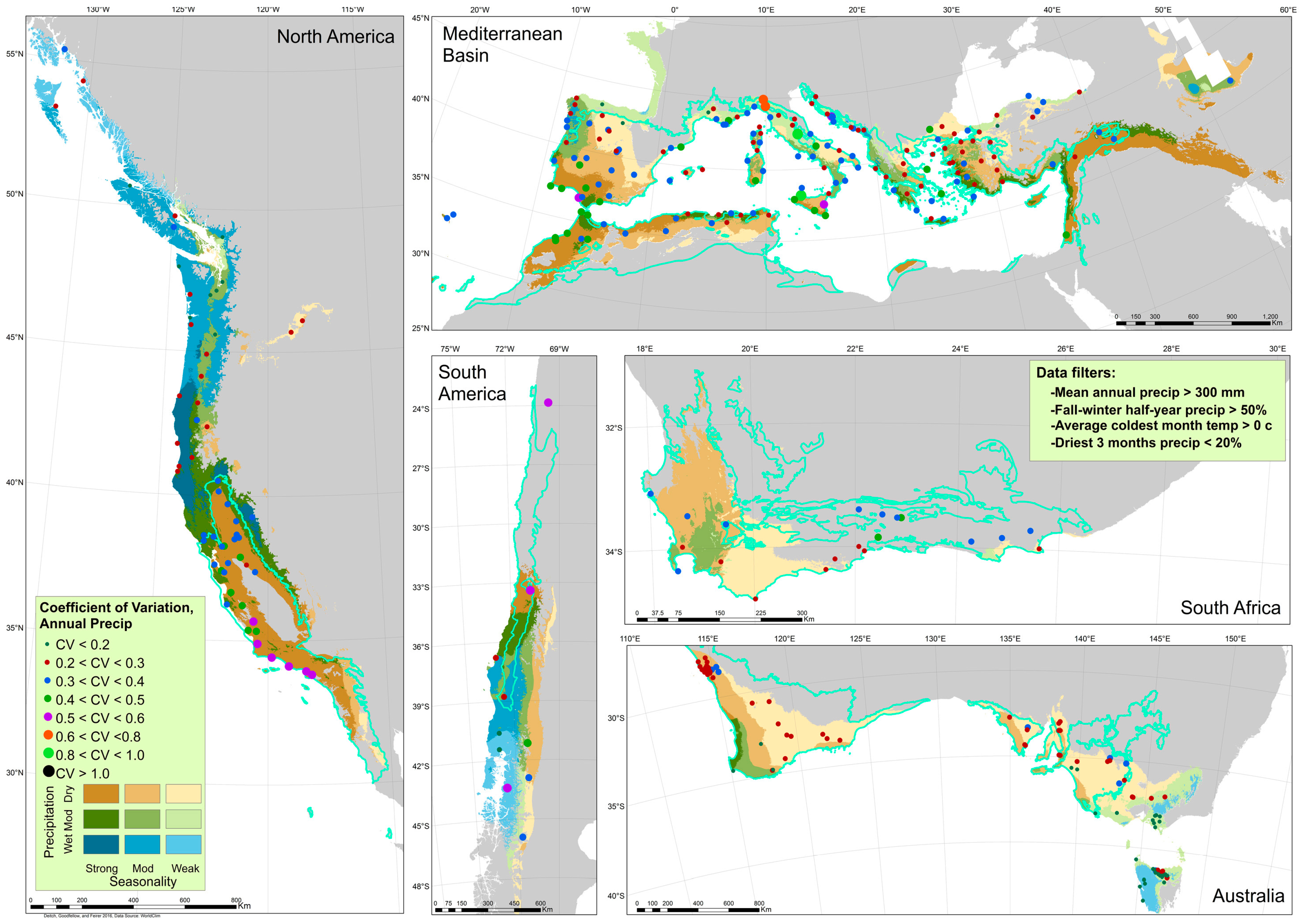

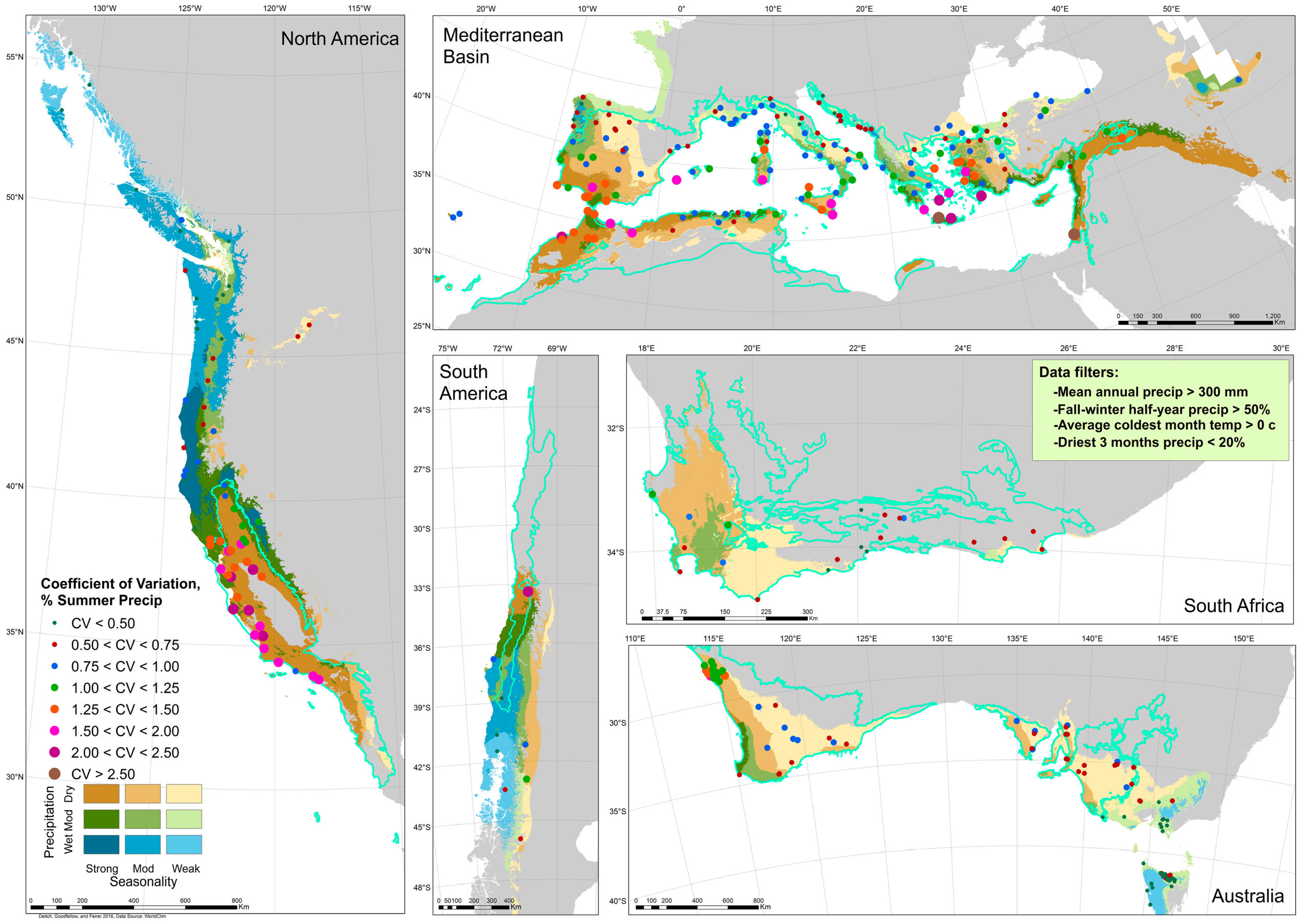
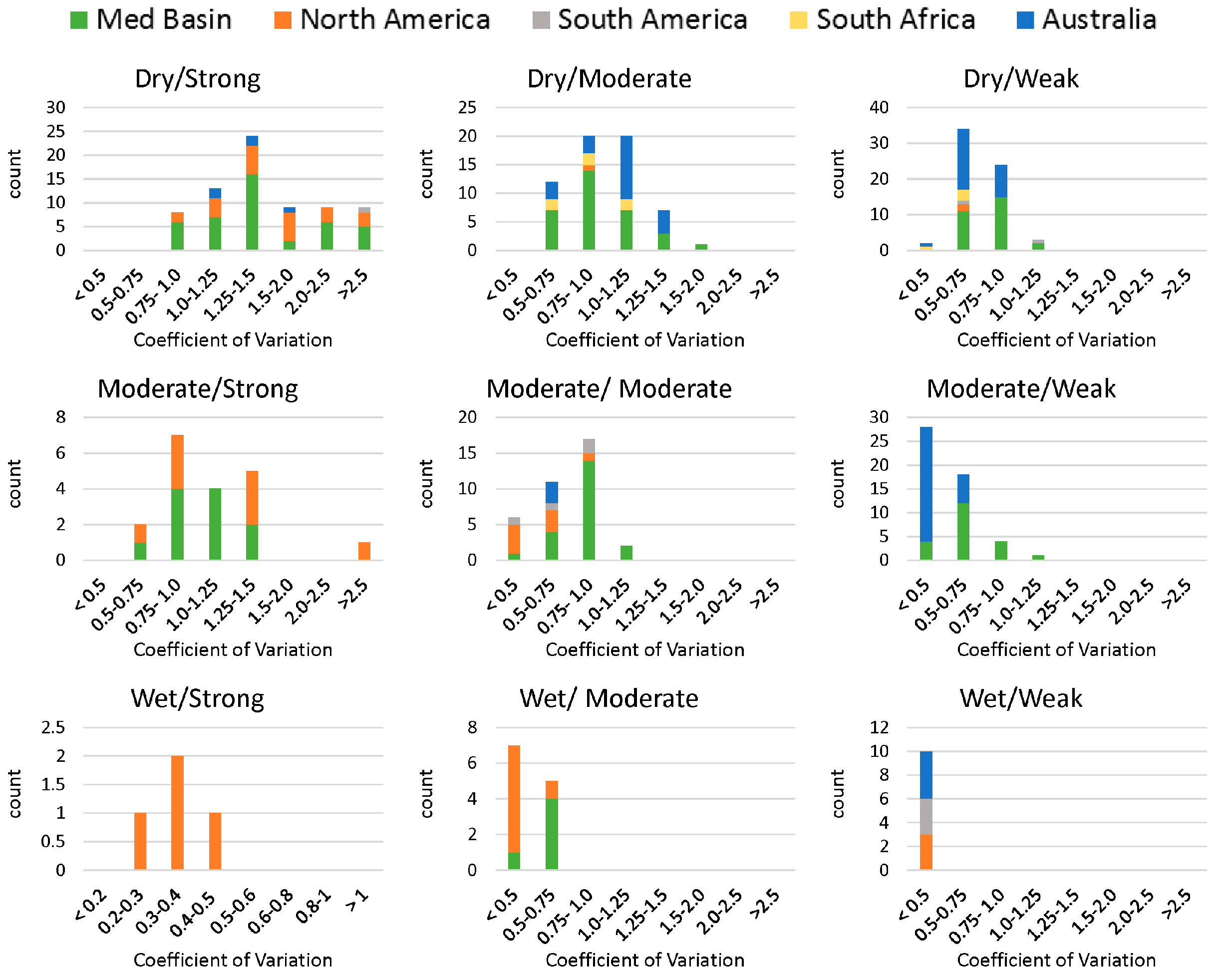
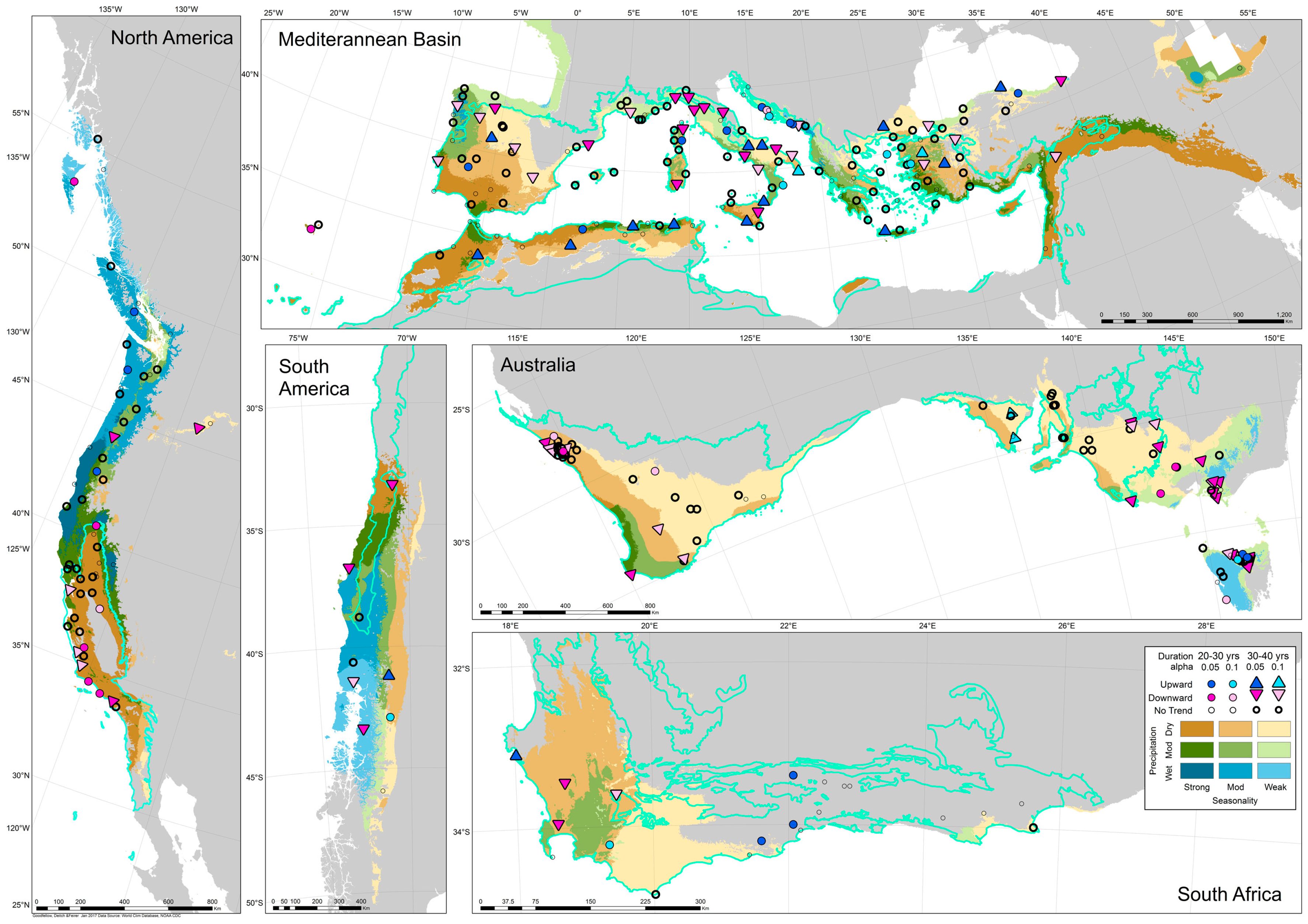

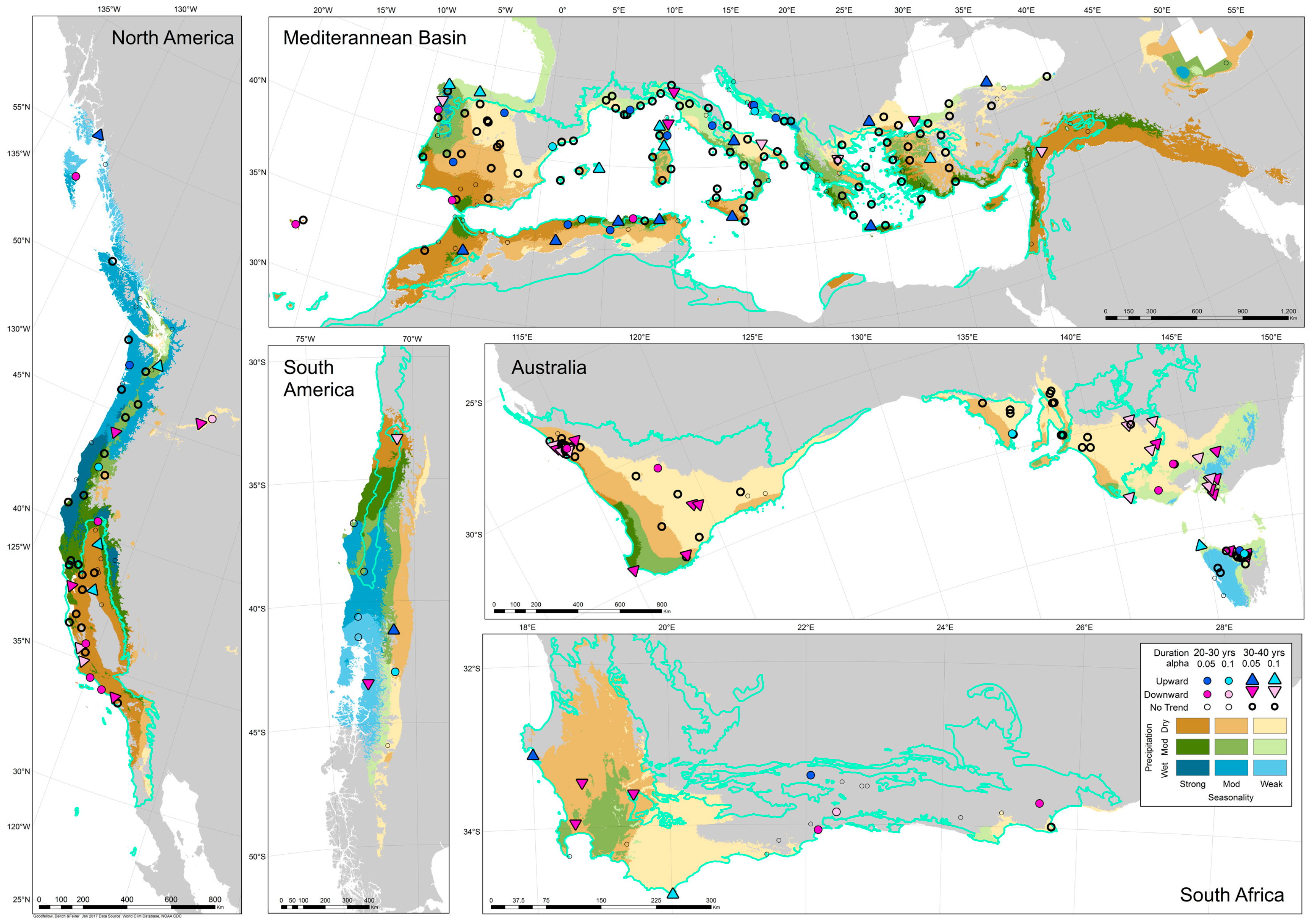

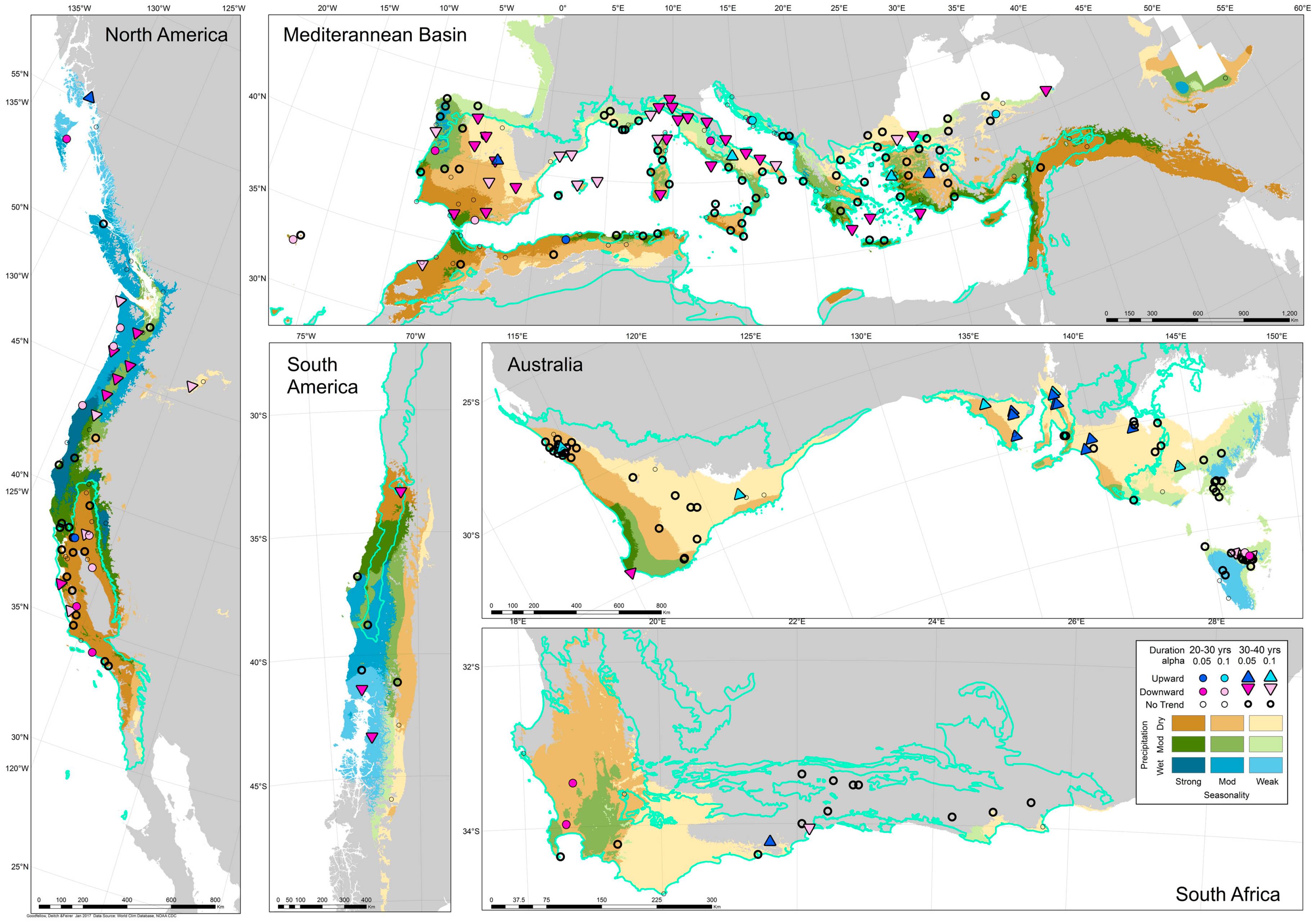
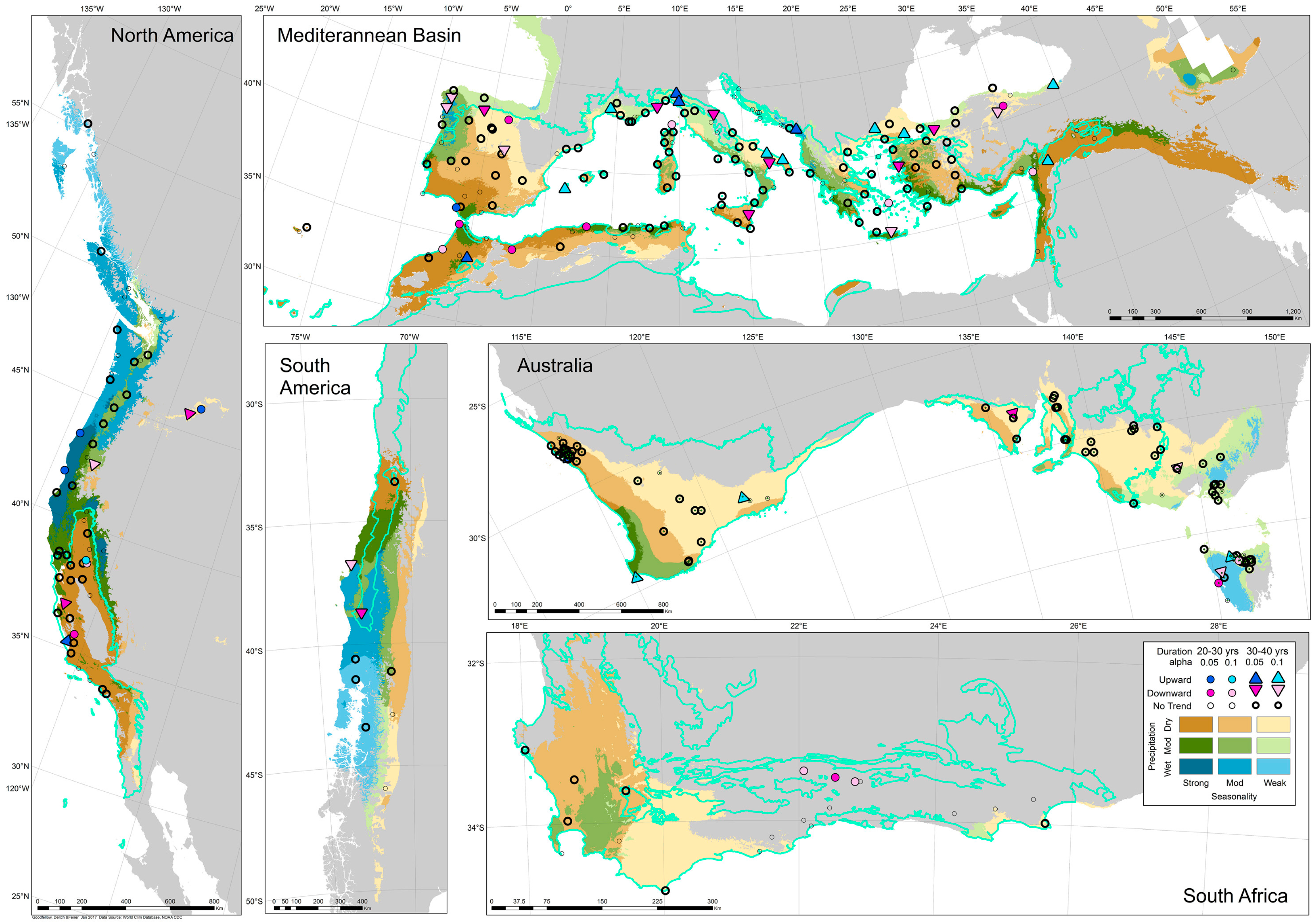
| Precipitation: | Seasonality: Percentage of Precipitation in Summer | ||
|---|---|---|---|
| Mean Annual Rainfall | Strong: <5% | Moderate: 5%–12% | Weak: 12%–20% |
| Dry climate: <700 mm | Dry climate/Strong seasonality | Dry climate/Moderate seasonality | Dry climate/Weak seasonality |
| Moderate climate: 700–1300 mm | Moderate climate/Strong seasonality | Moderate climate/moderate seasonality | Moderate climate/weak seasonality |
| Wet climate: >1300 mm | Wet climate/Strong seasonality | Wet climate/Moderate seasonality | Wet climate/Weak seasonality |
| Climate Category (Precip, Seasonality) | Australia | Med Region | North America | South America | South Africa |
|---|---|---|---|---|---|
| Biome area, km2 | 779.600 | 2,051,900 | 192,800 | 148,000 | 96,600 |
| Dry, weak, % | 38.6% | 11.1% | 2.4% | none | 14.9% |
| Dry, moderate, % | 17.4% | 20.3% | 4.4% | 0.2% | 19.4% |
| Dry, strong, % | 0.8% | 19.4% | 52.4% | 13.2% | 0.0% |
| Moderate, weak, % | 0.5% | 2.3% | 0.1% | none | 0.7% |
| Moderate, moderate, % | 4.3% | 8.2% | 0.2% | 5.3% | 5.6% |
| Moderate, strong, % | 1.7% | 6.1% | 10.5% | 10.9% | 0.0% |
| Wet, weak, % | None | 0.1% | None | None | None |
| Wet, moderate, % | None | 0.3% | None | 7.9% | None |
| Wet, strong, % | None | 0.05% | None | None | None |
| Very dry (<300 mm), % | 29% | 19% | 26% | 63% | 21% |
| Not seasonal, % | 8% | 13% | 4% | 0% | 38% |
© 2017 by the authors. Licensee MDPI, Basel, Switzerland. This article is an open access article distributed under the terms and conditions of the Creative Commons Attribution (CC BY) license (http://creativecommons.org/licenses/by/4.0/).
Share and Cite
Deitch, M.J.; Sapundjieff, M.J.; Feirer, S.T. Characterizing Precipitation Variability and Trends in the World’s Mediterranean-Climate Areas. Water 2017, 9, 259. https://doi.org/10.3390/w9040259
Deitch MJ, Sapundjieff MJ, Feirer ST. Characterizing Precipitation Variability and Trends in the World’s Mediterranean-Climate Areas. Water. 2017; 9(4):259. https://doi.org/10.3390/w9040259
Chicago/Turabian StyleDeitch, Matthew J., Michele J. Sapundjieff, and Shane T. Feirer. 2017. "Characterizing Precipitation Variability and Trends in the World’s Mediterranean-Climate Areas" Water 9, no. 4: 259. https://doi.org/10.3390/w9040259





